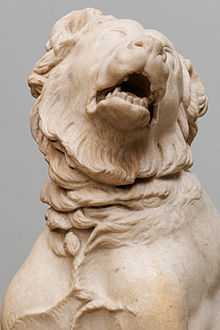Cropping (animal)

Cropping is the removal of part or all of the pinnae or auricles, the external visible flap of the ear, of an animal. Most commonly performed on dogs, it is an ancient practice that was once done for perceived health, practical or cosmetic reasons. In modern times, it is banned in many nations, but is still legal in a limited number of countries. Where permitted, it is seen only in certain breeds of dog such as the Pit bull, Doberman Pinscher, Schnauzer, Great Dane and Boxer.
The veterinary procedure is known as cosmetic otoplasty. Current veterinary science provides no medical, physical, environmental or cosmetic advantage to the animal from the procedure,[1][2] leading to concerns over animal cruelty related to performing unnecessary surgery on the animals. In addition to the bans in place in countries around the world, it is described in some veterinary texts as "no longer considered ethical."[1]
Cropping of large portions of the pinnae of other animals is rare, although the clipping of identifying shapes in the pinnae of livestock, called earmarks, was common prior to the introduction of compulsory ear tags.[3] Removal of portions of the ear of laboratory mice for identification, i.e. ear-notching, is still used. The practice of cropping for cosmetic purposes is rare in non-canines, although some selectively bred animals have naturally small ears which can be mistaken for cropping.
History and purposes

Ear cropping has been performed on dogs since ancient times.[4]
Traditional cropping
Historically, cropping was performed on dogs that might need to fight, either while hunting animals that might fight back or while defending livestock herds from predators, or because they were used for pit-fighting sports such as dogfighting or bear-baiting.[5][6] The ears were an easy target for an opposing animal to grab or tear.[5]
Cropping the ears of livestock guardian dogs was, and may still be, traditional in some pastoral cultures. The ears of working flock-defense dogs such as the Caucasian Shepherd Dog (Kavkazskaïa Ovtcharka)[7] and the Pastore Maremmano-Abruzzese were traditionally cropped to reduce the possibility of wolves or aggressor dogs getting a hold on them.[8] According to one description, cropping was carried out when puppies were weaned, at about six weeks. It was performed by an older or expert shepherd, using the ordinary blade shears used for shearing, well sharpened. The ears were cut either to a point like those of a fox, or rounded like those of a bear. The removed auricles were given to the puppy to eat, in the belief that it would make him more "sour";[8] the ears were first grilled.[9] An alternative method was to remove the ears from newly-born puppies by twisting them off; however, this left almost no external ear on the dog.[8] More than three hundred years ago, both ear-cropping and the use of spiked collars were described as a defense against wolves by Jean de la Fontaine in Fable 9 of Book X of the Fables, published in 1678.[10]
Dogs may have their ears cropped, legally or not, for participation in dogfights, themselves illegal in many jurisdictions.[11]
Cosmetic cropping
.jpg)
In the last 100 years or so, ear cropping has been performed more often for cosmetic purposes.[6][12] In nations and states where it remains legal, it is usually practiced because it is required as part of a breed standard for exhibition at dog shows.[12] There is no medical reason for cosmetic cropping,[1][4] although some claim that cropping prevents infection of the ear,[5] or that cropped ears enhance an animal's hearing.[13]

The veterinary procedure is known as "cosmetic otoplasty".[1] It is usually performed on puppies at 7 to 12 weeks of age.[14] After 16 weeks, the procedure is more painful and the animal has greater pain memory.[5] Up to 2/3 of the ear flap may be removed in a cropping operation, and the wound edges are closed with stitches. The ears are then bandaged and taped until they heal into the proper shape, though some do not stand upright, necessitating the operation to be redone.[14] While advocates of cropping downplay pain concerns, particularly in young puppies, both surgical and post-operative pain are believed to occur, and pain medication is not always provided.[4]
American veterinary schools do not generally teach cropping and docking, and thus veterinarians who perform the practice have to learn on the job.[4] There are also problems with amateurs performing ear-cropping, particularly at puppy mills.[4] Amateur cropping is not illegal in the United States. However, the Indiana Appellate Court described a situation that escalated into a prosecutable animal cruelty case in these terms:
"During the procedure, Elisea had an assistant bind the dogs' legs and mouths with tape. Once immobilized, Elisea marked a line along each ear with an eyeliner pencil and, after numbing the ears with ice, but without any anesthetic, cut the dogs' ears with a pair of office scissors. Vaseline and Bactine were placed on each cut, and Elisea told [the owner] to keep the puppies outside in the cold because their ears would heal more quickly."[15]
In the USA, although tail-docking remains common, ear-cropping is declining, save within the dog show industry.[12] However, many show ring competitors state they would discontinue the practice altogether if they could still "win in the ring."[16]
Animal welfare and law
The practice is illegal across most of Europe, including all countries that have ratified the European Convention for the Protection of Pet Animals, and most member countries of the Fédération Cynologique Internationale.[17] It is illegal in parts of Spain and in some Canadian provinces.[12] The situation in Italy is unclear; the ban effective 14 January 2007 may no longer be in force.[18]
Ear-cropping is still widely practiced in the United States and parts of Canada, with approximately 130,000 puppies in the United States thought to have their ears cropped each year[19] The American and Canadian Kennel Clubs both permit the practice.[12] The American Kennel Club (AKC) position is that ear cropping and tail docking are "acceptable practices integral to defining and preserving breed character and/or enhancing good health."[20] While some individual states have attempted to ban ear-cropping,[21] there is strong opposition from some dog breed organizations, who cite health concerns and tradition.[13]
The American Veterinary Medical Association "opposes ear cropping and tail docking of dogs when done solely for cosmetic purposes" and "encourages the elimination of ear cropping and tail docking from breed standards".[22] Specifically, the AVMA "has recommended to the American Kennel Club and appropriate breed associations that action be taken to delete mention of cropped or trimmed ears from breed standards for dogs and to prohibit the showing of dogs with cropped or trimmed ears if such animals were born after some reasonable date".[1] Some national chains of veterinary hospitals have voluntarily ceased to perform cosmetic surgeries on dogs.[16] The American Humane Association opposes ear-cropping "unless it is medically necessary, as determined by a licensed veterinarian".[23]
It has been suggested the cropping may interfere with a dog's ability to communicate using ear signals; there has been no scientific comparative study of ear communication in cropped and uncropped dogs.[24]
Status by country
| Country | Status | Ban/restriction date (if applicable) |
|---|---|---|
| Afghanistan | Unrestricted | |
| Argentina | Unrestricted | |
| Australia | Banned [25] | |
| Austria | Banned | 1 January 2005[26] |
| Belgium | Banned[26] | |
| Bolivia | Unrestricted | |
| Brazil | Banned for cosmetic purposes[26] | |
| Bulgaria | Banned | 2008 |
| Canada | Banned in Manitoba (1),[27] Newfoundland and Labrador (2), New Brunswick (3),[26] Nova Scotia (4),[28] and Prince Edward Island.[27] | (1) 3 February 2012 (2) 1978 (3) 15 October 2008 (4) 1 April 2010 |
| Chile | Unrestricted | |
| Colombia | Unclear | |
| Costa Rica | Unrestricted | |
| Croatia | Banned[26] | |
| Cyprus | Banned[26] | 1993 |
| Czech Republic | Banned | |
| Denmark | Banned[25] | 1 June 1996 |
| Egypt | Unrestricted | |
| England | Banned | 1899[29] |
| Estonia | Banned[26] | 2001 |
| Finland | Banned | 1 July 1996 [30] |
| France | Banned, except tail-docking | 1 January 2010[31] |
| Germany | Banned[32] | 1 May 1992 |
| Greece | Banned[26] | 1992 |
| Hungary | Banned[26] | |
| Iceland | Banned[26] | 2001 |
| India | Previously restricted, currently unrestricted [33] | |
| Indonesia | Unrestricted | |
| Ireland | Banned | |
| Israel | Banned[32] | 2000 |
| Italy | Banned or unclear | |
| Kuwait | Unrestricted | |
| Latvia | Banned[26] | |
| Lebanon | Unrestricted | |
| Lithuania | Banned[26] | |
| Luxembourg | Banned[26] | 1991[34] |
| Malaysia | Unrestricted | |
| Morocco | Unrestricted - Morocco has no animal protection laws | |
| Mauritius | Unrestricted | |
| Mexico | Unrestricted | |
| Nepal | Unrestricted | |
| Netherlands | Banned[26] | 1 September 2001 |
| New Zealand | Banned[25] | 2004 |
| Northern Ireland | Banned[26] | 2011 |
| Norway | Banned[25] | 1987 |
| Panama | Unrestricted | |
| Peru | Unrestricted | |
| Philippines | Unrestricted | |
| Poland | Banned[26] | 1997 |
| Portugal | Banned | |
| Romania | Banned[26] | 2008 |
| Russia | Restricted | |
| Scotland | Banned[26] | 1899[29] |
| Slovakia | Banned[26] | 1 January 2003 |
| Slovenia | Banned[35] | April 2007 |
| South Africa | Banned[26] | June 2008 |
| Spain | Banned in autonomies of Catalonia and Andalucia[26] | |
| Sri Lanka | Unrestricted | |
| Sweden | Banned[26] | 1989 |
| Switzerland[26] | Banned | 1997 |
| Taiwan | Unrestricted | |
| United States | Unrestricted (some states, including New York[21] and Vermont, have considered bills to make the practice illegal) | 2003 |
| Virgin Islands | Banned[26] | 2005 |
| Wales | Banned[26] | 1899[29] |
Naturally small ears
Some animals, such as the Lamancha goat, have ears which are naturally small as the result of selective breeding, and some people mistakenly believe their ears to be cropped.[36][37]
In other animals, small ears may result from a genetic mutation or the emergence of a genetically recessive trait, such as in Highland cattle, where the appearance of small ears, appearing to have its pinnae cropped, is viewed as a defect.[38]
See also
- Cropping (punishment)
- Docking (animal)
- Docking (dog)
- Ear shaping
- Livestock dehorning
- Overview of discretionary invasive procedures on animals
- Polled livestock
Notes
References
- ↑ 1.0 1.1 1.2 1.3 1.4 Slatter, Douglas H. (2002) Textbook of small animal surgery 3rd edition. Philadelphia: W.B. Saunders (imprint of Elsevier Health Sciences), 2896 pages, ISBN 978-0-7216-8607-3, p.1746
- ↑ "Ear Cropping: Is it right for your dog?". Pet MD.
- ↑ Lexique Camarguais (in French) Manade Devaux. "Lexicon of Camargue terms" Accessed September 2011
- ↑ 4.0 4.1 4.2 4.3 4.4 Broughton, Amy L. (2003) Cropping and Docking: A Discussion of the Controversy and the Role of Law in Preventing Unnecessary Cosmetic Surgery on Dogs Michigan State University - Detroit College of Law. Accessed September 2011.
- ↑ 5.0 5.1 5.2 5.3 Ear Cropping: Correct or Cruel? Briarlea Bouvier Kennel. Accessed September 2011.
- ↑ 6.0 6.1 Murgai, Major R.P. (1996) Handbook on Dogs New Delhi: New Age International, p.46
- ↑ Samsonova, Anna Caucasian Shepherd Dog (Kavkazskaïa Ovtcharka) Fédération Cynologique Internationale FCI-Standard N° 328, 2 February 2011. Accessed September 2011
- ↑ 8.0 8.1 8.2 Breber, Paolo (1983) Il Cane da Pastore Maremmano-Abruzzese (in Italian) 2nd edition. Firenze: Olimpia "The Maremmano-Abruzzese shepherd dog" pp.98–99
- ↑ MacDonell, Anne, Amy Atkinson (ill.) (1907) In the Abruzzi New York: F.A. Stokes p. 18
- ↑ Wright, Elizur (trans.), Jean de la Fontaine (1862) The fables of La Fontaine, translated [in verse] from the French London: Miller p.74
- ↑ Curtis, Patricia (2002) City dog: choosing and living well with a dog in town New York: Lantern Books ISBN 978-1-59056-000-6 p.37
- ↑ 12.0 12.1 12.2 12.3 12.4 Ear cropping and tail docking The Canadian Federation of Humane Societies/Fédération des sociétés canadiennes d'assistance aux animaux (CFHS/FSCAA). Accessed September 2011.
- ↑ 13.0 13.1 American Kennel Club Gazette, January 1993 American Boxer Club. Accessed September 2011
- ↑ 14.0 14.1 Practice of Dogs Ear cropping [sic] Doggie's Paradise. Accessed September 2011
- ↑ Indiana Court of Appeals: Elisea v. State, Indiana 777 N.E.2d 46 (Ind. App. 2002) Animal Legal and Historical Center. Accessed September 2011.
- ↑ 16.0 16.1 Weise, Elizabeth 'Banfield pet hospitals ban tail docking, ear cropping on dogs' USA Today, 30 July 2011. Accessed September 2011.
- ↑ Fogle, Bruce. K-I-S-S Guide to Living with a Dog Stop the Crops. Accessed September 2011
- ↑ Cani pericolosi, l'ordinanza della Turco "Stop al taglio di orecchie e coda" (in Italian) La Repubblica, 15 January 2007. Accessed September 2011. "Dangerous dogs, the ordinance of Turco: 'stop the cutting of ears and tails' "
- ↑ "Cropping and Docking: A Discussion of the Controversy and the Role of Law in Preventing Unnecessary Cosmetic Surgery on Dogs". Animallaw.info. Retrieved 2013-04-17.
- ↑ Ear Cropping, Tail Docking and Dewclaw Removal American Kennel Club Canine Legislation Position Statements
- ↑ 21.0 21.1 "NEW CALL TO ACTION FOR AMENDED NY STATE CROP/DOCK BILL". American Kennel Club. 9 June 2006. Retrieved 2007-12-31.
- ↑ Ear Cropping and Tail Docking of Dogs American Veterinary Medical Association, November 2008. Accessed September 2011
- ↑ Ear cropping The American Humane Association. Accessed September 2011.
- ↑ Coren, Stanley (2001) How to speak dog: mastering the art of dog-human communication New York: Simon & Schuster ISBN 978-0-7432-0297-8 chap. 9 [pages unnumbered]
- ↑ 25.0 25.1 25.2 25.3 "Ear cropping and tail docking". Canadian Federation of Humane Societies.
- ↑ 26.0 26.1 26.2 26.3 26.4 26.5 26.6 26.7 26.8 26.9 26.10 26.11 26.12 26.13 26.14 26.15 26.16 26.17 26.18 26.19 26.20 26.21 26.22 26.23 26.24 Δικτυακός Τόπος Διαβουλεύσεων (Website consultation) (mostly in English) Υπουργείο Αγροτικής Ανάπτυξης και Τροφίμων (Ministry of Rural Development and Food, Athens, Greece), April 2011. Accessed September 2011.
- ↑ 27.0 27.1 CBC News (February 10, 2012)Ear cropping of dogs banned in Manitoba Accessed February 10 2012.
- ↑ CBC News (March 25, 2010)N.S veterinarians ban tail docking Accessed February 10 2012.
- ↑ 29.0 29.1 29.2 Johnston, Beatrice L. (1970) For those who cannot speak: a history of the Canadian Society for the Prevention of Cruelty to Animals, 1869-1969 City of Laval, P.Q.: Dev-Sco Publications p.13
- ↑ Finnish Animal Protection Law (in Finnish)
- ↑ French Animal Protection Law (in French)
- ↑ 32.0 32.1 A review of the scientific aspects and veterinary opinions relating to tail docking in dogs
- ↑ Now, you can dock dogs' tail
- ↑ WSAVA Tail Docking Position Statement
- ↑ Slovene Animal Protection Act (in slovene language)
- ↑ Woods, Dale L.; Hendrickson, Pat (1978), The American Lamancha, and its Ears., Dairy Goat Journal
- ↑ " What did we do to its ears?"Accessed September 19, 2011.
- ↑ Crop Ear. what does it look like? Cruachan Highland Cattle. Accessed September 2011.]
External links
| Wikimedia Commons has media related to Dog ear cropping. |
- https://www.avma.org/KB/Resources/Backgrounders/Pages/Welfare-Implications-of-Ear-Cropping-Dogs-Backgrounder.aspx
- https://www.avma.org/KB/Policies/Pages/Ear-Cropping-and-Tail-Docking-of-Dogs.aspx
- http://www.animallaw.info/articles/dduscroppingdocking.htm
- http://www.ncbi.nlm.nih.gov/pmc/articles/PMC2777283/
- http://www.aahanet.org/Library/CropDock.aspx